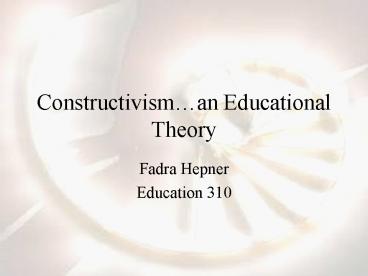Constructivisman Educational Theory - PowerPoint PPT Presentation
1 / 20
Title:
Constructivisman Educational Theory
Description:
Jean Piaget. Lev Vigotsky. Jerome Bruner. But first. Constructivism..What is it? ... based on Swiss Biologist Jean Piaget's research on child development & learning ... – PowerPoint PPT presentation
Number of Views:397
Avg rating:3.0/5.0
Title: Constructivisman Educational Theory
1
Constructivisman Educational Theory
- Fadra Hepner
- Education 310
2
Constructivism
- What is it?
- What does it have to tell us?
- How can we apply it to our work?
3
During the 1930s and 40s, Constructivism was
the leading view of Public school educators in
the U.S.
- Nothing terribly new about it!
- Many basic beliefs stated by Dewey among others
- Comprised primarily of the research by
Jean Piaget Lev Vigotsky Jerome Bruner
But first...
4
Constructivism..What is it?
- An educational theory that places emphasis on the
learner - Teachers role Act as a facilitator
- Based on the idea that All knowledge is
CONSTRUCTED based on previous experiences
5
But what does this mean?
- In order to understand something, we MUST be
able to relate it to something else - If at all possible, APPLY this knowledge during
the lesson to foster concrete connections - Differs from traditional view the mind is a
blank tablet
6
Instead, Constructivism views knowledge as
assimilated into existing schema
- Idea largely based on Swiss Biologist Jean
Piagets research on child development learning - Piagets theory states that children learn by
creating mental maps or schemes - These maps or schemes are added to and adapted as
needed to help them understand their environment - Structure becomes more complex as child develops
7
4 Developmental stages according to Piaget
- 1. Sensory motor stage (birth-2 yrs)
- -through physical interaction with environment,
child develops set of concepts about reality
how it works - -stage where child is unaware that if an object
is not seen it still exists (object permanence)
8
2. Preoperational stage (2-7)
- Child needs concrete physical situations and is
unable to conceptualize in the abstract - -needs to see, hear, feel in order to understand
something
9
3. Concrete operations (7-11)
- Child begins to conceptualize based on physical
experiences - -creates logical structures to explain his/her
environment - -abstract problem solving possible
- Example math with s, not objects
10
4. Formal operations (12)
- Cognitive structures are like an adult and
include conceptual reasoning - -Piaget classified as a cognitive
constructivist focusing on processes of the mind
and its effects on learning
11
Lev Vigotsky
- Russian psychologist philosopher in 1930s
usually associated with Social Constructivism - Social Constructivism emphasized the effects of
ones environment (family, friends, culture
background) have on learning - Today, Co-Constructivism Seems to prevail,
incorporating Cognitive and Social aspects
12
Modern Constructivism!!!
- Jerome Bruner most recent contributor
- 1966-1990 Has incorporated social and cognitive
aspects - These ideas originated from a conference for math
and science learning
13
3 Principles of Constructivism
- Instruction must be concerned with experiences
and contexts that make students willing able to
learn (readiness) - Must be structured so it is easily grasped
(spiral organization) - Should be designed to facilitate extrapolation or
fill in the gaps (going beyond information
given)
14
During the math and science conference, a
modified lesson plan was developed with Bruners
assistance
- The five Es
- Engage- do this! Engage the students and get them
interested in learning - Ex ask a question, define a problem, surprise
them, use problematic situations - TWO VOLUNTEERS PLEASE!
15
Explore
- Get the students directly involved in the
material - Have them work in teams
- Act as a facilitator
- Use their inquiry to drive the process
16
Explain
- Explanations come from
- -Students working together
- -Teacher introducing concepts and vocabulary for
experiences Example magnets-attracting force - This is also the time for the teacher to
determine levels of understanding and clarify
misconceptions - Drawing, writing and video are great tools to
help the teacher assess development and growth
17
Elaborate
- Students expand on concepts learned
- Make connections
- Apply understandings to own environment world
around them - These connections lead to further inquiry new
understandings
18
Evaluate
- On-going diagnostic process
- Can occur at all points of the instructional
process - -Examples rubrics, teacher observation, student
interviews, portfolios, project problem based
learning products, etc. - Used to guide teacher in further planning of
lessons - May also be utilized by the students Ex
Feedback Fridays
19
To summarize
- Learning is active
- Engage the students on their own cognitive level
- Make it interesting!
- Work in groups
- Act as a facilitator, not a record player
- Make learning cyclical. They should have more
questions when the lesson is over!
20
Bibliography!!!!!
- http//www.miamisci.org/ph/lpintro5e.html
- http//www.funderstanding.com/piaget.cfm
- http//web.psych.ualberta.ca/mike/Pearl_Street/Di
ctionary/contents/P/piagets_stages.html - http//pdts.uh.edu/srmehall/theory/social.html
- http//www.artsined.com/teachingarts/Pedag/Constru
ctivist.html































